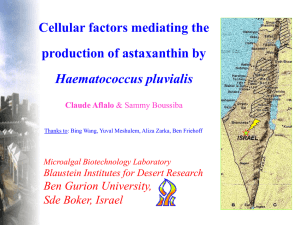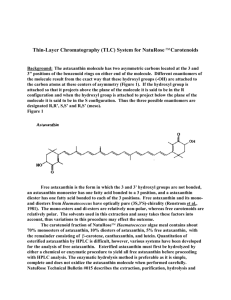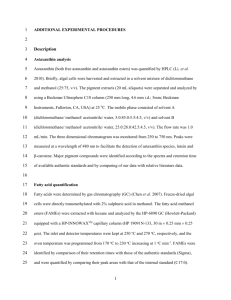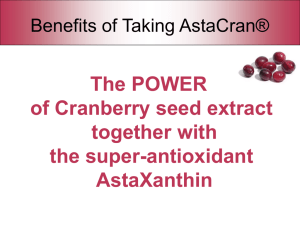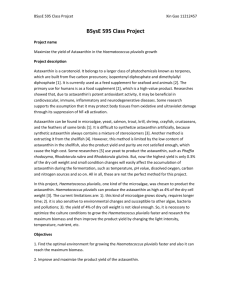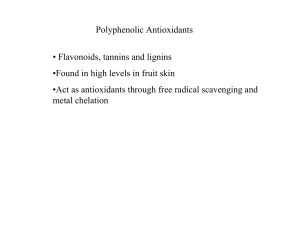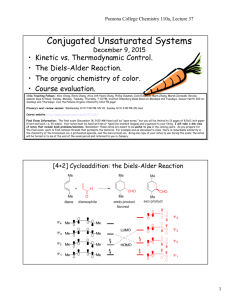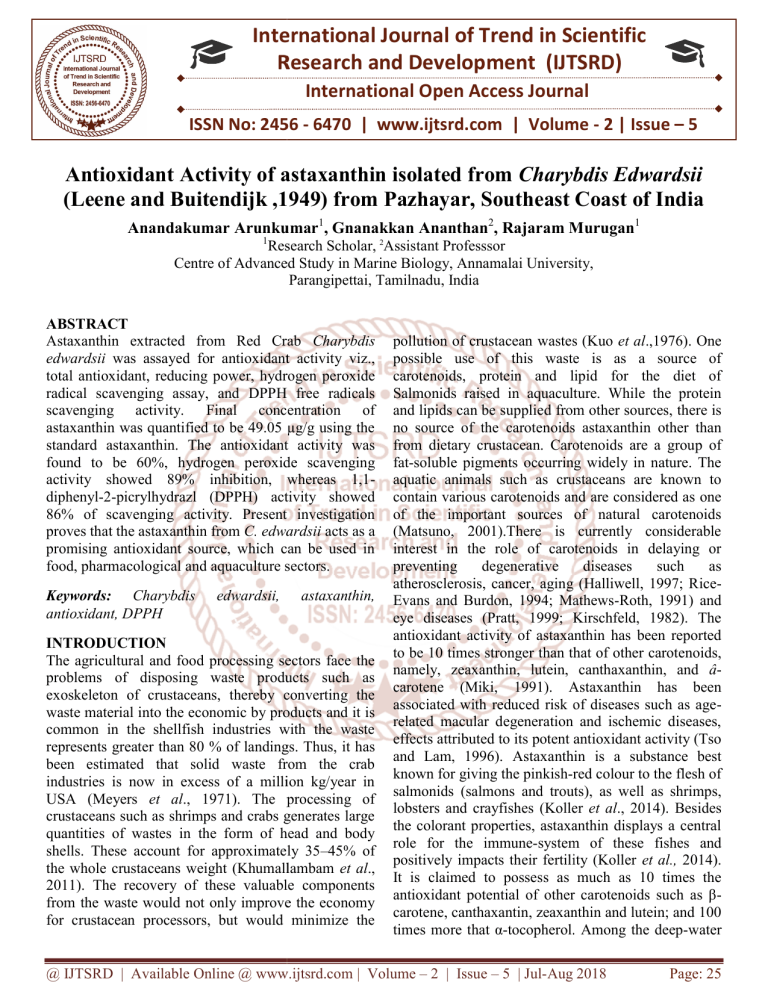
International Journal of Trend in Scientific
Research and Development (IJTSRD)
International Open Access Journal
ISSN No: 2456 - 6470 | www.ijtsrd.com | Volume - 2 | Issue – 5
Antioxidant Activity of aastaxanthin isolated from Charybdis Edwardsii
(Leene and Buitendijk ,1949) from Pazhayar, Southeast Coast of India
Anandakumarr Arunkumar1, Gnanakkan Ananthan2, Rajaram Murugan1
1
Research Scholar
Scholar, 2Assistant Professsor
Centre off Advanced Study in
n Marine Biology, Annamalai University,
Parangipettai, Tamilnadu, India
ABSTRACT
Astaxanthin extracted from Red Crab Charybdis
edwardsii was assayed for antioxidant activity viz.,
total antioxidant, reducing power, hydrogen peroxide
radical scavenging assay, and DPPH free radicals
scavenging activity. Final concentration of
astaxanthin was quantified to be 49.05 µg/g using the
standard astaxanthin.
axanthin. The antioxidant activity was
found to be 60%, hydrogen peroxide scavenging
activity showed 89% inhibition, whereas 1,1
1,1diphenyl-2-picrylhydrazl
picrylhydrazl (DPPH) activity showed
86% of scavenging activity. Present investigation
proves that the astaxanthin from C. edwardsii acts as a
promising antioxidant source, which can be used in
food, pharmacological and aquaculture sectors.
Keywords: Charybdis
antioxidant, DPPH
edwardsii,
astaxanthin,
INTRODUCTION
The agricultural and food processing sectors face the
problems of disposing waste products such as
exoskeleton of crustaceans, thereby converting the
waste material into the economic by products and it is
common in the shellfish industries with the waste
represents greater than 80 % of landings. Thus, it has
been estimated that solid waste from the crab
industries is now in excess of a million kg/year in
USA (Meyers et al.,., 1971). The processing of
crustaceans such as shrimps and crabs generates large
quantitiess of wastes in the form of head and body
shells. These account for approximately 35
35–45% of
the whole crustaceans weight (Khumallambam et al.,
2011). The recovery of these valuable components
from the waste would not only improve the economy
for crustacean processors, but would minimize the
pollution of crustacean wastes (Kuo et al.,1976). One
possible use of this waste is as a source of
carotenoids, protein and lipid for the diet of
Salmonids raised in aquaculture. While the protein
and lipids can be supplied
plied from other sources, there is
no source of the carotenoids astaxanthin other than
from dietary crustacean. Carotenoids are a group of
fat-soluble
soluble pigments occurring widely in nature. The
aquatic animals such as crustaceans are known to
contain various carotenoids and are considered as one
of the important sources of natural carotenoids
(Matsuno, 2001).There is currently considerable
interest in the role of carotenoids in delaying or
preventing
degenerative
diseases
such
as
atherosclerosis, cancer, aging
g (Halliwell, 1997; RiceRice
Evans and Burdon, 1994; Mathews-Roth,
Mathews
1991) and
eye diseases (Pratt, 1999; Kirschfeld, 1982). The
antioxidant activity of astaxanthin has been reported
to be 10 times stronger than that of other carotenoids,
namely, zeaxanthin, lutein,
ein, canthaxanthin, and âcarotene (Miki, 1991). Astaxanthin has been
associated with reduced risk of diseases such as ageage
related macular degeneration and ischemic diseases,
effects attributed to its potent antioxidant activity (Tso
and Lam, 1996). Astaxanthin
nthin is a substance best
known for giving the pinkish-red
red colour to the flesh of
salmonids (salmons and trouts), as well as shrimps,
lobsters and crayfishes (Koller et al., 2014). Besides
the colorant properties, astaxanthin displays a central
role for the immune-system
system of these fishes and
positively impacts their fertility (Koller et al., 2014).
It is claimed to possess as much as 10 times the
antioxidant potential of other carotenoids such as ββ
carotene, canthaxantin, zeaxanthin and lutein; and 100
times more that α-tocopherol.
tocopherol. Among the deep-water
deep
@ IJTSRD | Available Online @ www.ijtsrd.com | Volume – 2 | Issue – 5 | Jul-Aug
Aug 2018
Page: 25
International Journal of Trend in Scientific Research and Development (IJTSRD) ISSN: 2456-6470
crab resources, the most promising is that of
Charybdis edwardsii which gave a catch rate of 3500
kg/h in try net hauls carried out off Mangalore and
Ponnani (Silas, 1969). The aim of the present study is
to evaluate the antioxidant activity of astaxanthin
extracted from Charybdis edwardsii.
MATERIALS AND METHODS
Collection
The study animal Charybdis edwardsii was sourced
from Pazhayar fish landing centre of (Lat 11º 21’22”
N; long 79º 50’55” E) South east coast of India,
Average weight of crab ranged from25 to 36 grams.
Crabs were washed in tap water to remove debris and
soil then stored in deep freezer until further analysis.
Extraction
Astaxanthin content was determined according to the
modified method of Tolasa et al. (2005) and
Metusalach et al. (1997). Dried crab sample (30 g)
was extracted thrice, with 50ml of acetone using
incubating shaker for 48 hrs at room temperature.
After extraction,the samples were centrifuged at
4000g at 4°C for 5 min. To separate the
waterinsoluble compounds, the acetone extracts of the
sampleswere transferred to 40 ml of petroleum ether
in a 250 mlseparating funnel. Then, 100 ml of
distilled water containing 0.5% (w/v) sodium chloride
was added to the mixture. After continuous shaking
by hand, approximately 20 minutes later, the
petroleum ether layer was separated and
transferredinto a 50 ml volumetric flask.
Quantification of astaxanthin
The extracted astaxanthin is re dissolved in 3 ml of
acetone and read @ 468 nm.
AST (μg/g) = A468nm × V extract × Dilution factor
0.2 × W sample
Where, A is absorbance, V is volume of extract, 0.2 is
theA468 of 1 µg/g of standard astaxanthin and W is
weight of sample in grams. (Simpson and Haard,
1985).
Total antioxidant activity
Total Antioxidant Capacity (TAC) reagent was
prepared by mixing of 7.45 ml sulphuric acid (0.6
mM solution), 0.9942 g of sodium sulphate (28 mM
solution) and 1.2359 g of ammonium molybdate (4
mM solution) in 250 ml of distilled water. 300 μl of
isolated astaxanthin from the crab was dissolved in 3
ml of TAC reagent. Distilled water was used as blank.
Absorbance of all sample mixtures was measured at
695 nm. Gallic acid was used as standard to determine
totalantioxidant activity (Khan et al., 2009).
Reducing power
1.0 ml of isolated astaxanthin from the crab was
mixed with 2.5 ml of phosphate buffer (0.2 M, pH6.6) and 2.5 ml of potassium ferric cyanide (1%).
Reaction mixture was kept in a water bath at 50°C for
20 minutes. After incubation, 2.5 ml of
Trichloroacetic acid (10%) was added and centrifuged
at 650 rpm for 10 minutes. From the supernatant, 2.5
ml solution was mixed with 2.5 ml of distilled water
and 0.5 ml of ferric chloride (0.1%). Absorbance of
the solution was measured at 700 nm after every 10
minutes intervals up to 30 minutes. Increased
absorbance indicated increased reducing power
(Govindarajan et al., 2003).
Hydrogen peroxide radical scavenging assay
Hydrogen peroxide (10 mM) solution was prepared in
the phosphate buffer saline (0.1 M, PH-7.4). 1 ml
(0.25 mg) of the isolated astaxanthin from the crab
was rapidly mixed with 2 ml of hydrogen peroxide
solution. The samples were incubated at 37°Cfor 10
min and the absorbance was measured at 230 nm
against a blank (without hydrogen peroxide;
Govindarajan et al., 2003). The percentage of
scavenging of hydrogen peroxide was calculated
using the following formula:
% Scavenging = [Absorbance of control - Absorbance
of test sample/Absorbance of control] ×100
Where blank – phosphate buffer; control – hydrogen
per oxide without astaxanthin; test
astaxanthin with hydrogen peroxide.
1, 1-diphenyl-2-picrylhydrazl (DPPH) free radicals
scavenging activity
1 ml of test solution was mixed with 1 ml of 0.1 mM
DPPH in methanol. The mixture was incubated in
dark place for 30 min at 25°C. After 30 minutes,
absorbance wasrecorded at 517 nm. (Shimada et al.,
1992)The percentage of DPPH free radicals
scavenging activity was calculated by following
equation:
% Scavenging = [Absorbance of control - Absorbance
of test sample/Absorbance of control] ×100
Where blank – methanol; control - DPPH in methanol
without astaxanthin; test – astaxanthin with DPPH in
methanol.
@ IJTSRD | Available Online @ www.ijtsrd.com | Volume – 2 | Issue – 5 | Jul-Aug 2018
Page: 26
International Journal of Trend in Scientific Research and Development (IJTSRD) ISSN: 2456-6470
RESULTS AND DISCUSSION
Quantification of astaxanthin
The concentration of astaxanthin obtained from C.
edwardsii was found to be 49.05 μg/g. The present
investigation was correlated with the earlier findings
of Renata Aline dos Santos da Fonseca et al.(2011)
and (Shahidi and Synowiecki, 1990).
0.09 for 30 minutes, which is followed by astaxanthin
standard that shows 0.05 for 10 mins and 0.08 for 30
minutes. The reducing ability of Red crab
(C.edwardsii) was0.04 for 10 mins and 0.07 for30
mins. Thus, the result correlates astaxanthin as good
reducing agents. Similar result was reported by Yen et
al. (2014) and Soundarapandian et al. (2014).
Antioxidant activity of astaxanthin standard and
isolated astaxanthin
Antioxidant properties of astaxanthin was evaluated
since, astaxanthin possess the properties of free
radical scavenging, anti-aging, anti-cancer, antiinflammatory etc. In the present investigation, total
antioxidant property of astaxanthin was evaluated the
antioxidant potential of 68 % was found in
astaxanthin standard, 60 % was found in C. edwardsii
but it is lower than that of gallic acid the standard
drug i.e. 75 % (Fig. 1). Sudhakar et al.(2011) recorded
the total antioxidant activity ranged from 28.52 % to
80.26 % in P. Sanguinolentus crab shell chitosan
sample. The present test was also correlated with the
study of Soundarapandian et al.(2014) in which the
total antioxidant activity was found to be 32 to 49% in
soft and hard shelled crabs of C. Lucifera and 86 %
for Gallic acid.
Hydrogen peroxide radical scavenging assay
Hydrogen peroxide is a standard free radical
compound which enhances the lipid peroxidase
acitivity. During the present study, the ability of
astaxanthin to scavenge hydrogen
peroxidewas assayed. The maximum activity of 89%
inhibition was seen in ascorbic acid followed by
standard astaxanthin of 68 % inhibition. The
scavenging activity of 67 % (Fig. 2) was seen in C.
Edwardsii (Red crab), these results further proves that
astaxanthin has a good antioxidant property. The
present study was corelated with the study of
Soundarapandian et al. (2014).
Figure2. Percentage of hydrogen peroxide
scavenging assay
Figure1. Percentage of total antioxidant activity
Reducing power assay
The present investigation revealed the reducing effect
of astaxanthin. Astaxanthin possess the ability to
donate an electron to free radicals which leads to
neutralization of the radicals. Reducing power was
evaluated using ferric ions. There was increase in
Optical Density for every 10mins in both the standard
and the test samples. Due to increase in Optical
Density, the result reveals the good reducing
property.In reducing power assay, standard drug
ascorbic acid was dominating agent that shows the
maximum reducing ability i.e 0.06 for 10mins and
Scavanging ability on 1, 1- diphenyl-2picrylhydrazl radicals (DPPH) assay
DPPH is one of the stable free radical used for the
assay of scavenging capacity of astaxanthin. The
DPPH activity of standard Gallic acid was found to be
86%. Standard astaxanthin had 79 %, where as C.
edwardsii (Red Crab) possessed72 % (Fig. 3).
@ IJTSRD | Available Online @ www.ijtsrd.com | Volume – 2 | Issue – 5 | Jul-Aug 2018
Page: 27
International Journal of Trend in Scientific Research and Development (IJTSRD) ISSN: 2456-6470
5. Koller, M., Muhr, A., Braunegg, G. (2014).
Microalgae as versatile cellular factories for
valued products. Algal Research, 6, 52-63.
6. Kuo H.C., Lee, T. C., Kamata ,T., and Simpson,
K.L., 1976. Red crab processing waste as a
carotenoid source for rainbow trout. 47-51.
Figure3. Percentage of 1, 1- diphenyl-2picrylhydrazl radicals (DPPH) activity
Hence the results proved both Standard astaxanthin
and astaxanthin extracted from Charybdis edwardsii
possessed a good DPPH activity which predicted that
DPPH would have picked up the electron in the
presence of a free radical scavenger which is reflected
as the percentage of DPPH activity. Similar result was
reported by Yen et al.(2014) as it showed 82.9%
scavenging activity. From the study, it has been
proved that Charybdis edwardsii acts as a potent
source of natural antioxidants, which can be used in
the food and pharmaceutical sectors.
ACKNOWLEDGEMENT
The authors wish to thank the Dean and Director of
CAS in Marine Biology and authorities of Annamalai
University for providing facilities.
REFERENCES
1. Govindarajan, R., Rastogi, S., Vijayakumar, M.,
Shirwaikar, A., and Rawat, A.K.S., 2003. Studies
on the Antioxidant Activities of Desmodium
gangeticum. Bio Pharmal Bulle, 26 (10): 14241427.
2. Halliwell, B., Antioxidants and human disease: A
general introduction. Nutr. Rev. 1997, 55, 544552.
3. Khan, M.A., Shahwar, D., Ahmad, N., Khan, Z.
and Ajaib, M., 2009. Chemical constituents of
Carissa opaca extracts and their evaluation as
antioxidant and preservative in Edible Oils. Asian
J Chem, 22 (1): 379- 388.
4. Khumallambam, M., Rama, S., Karuppannan, R.
R., Manjabhat, S. N., 2011. Antioxidant activity of
protein isolate obtained by the pH shift technique
from hydrolyzed and unhydrolyzed shrimp
processing discards. Journal of Aquatic Food
Product
Technology
20,
209–221.
doi:10.1080/10498850.2011.559618
7. Mathews-Roth, M., Recent progress in the
medical applications of carotenoids. Pure Appl.
Chem. 1991, 63, 147-156.
8. Matsuno, T., 2001. Aquatic animal carotenoids.
Fisheries Science 67, 771–783.
9. Metusalach, B., Brown, J. A. & Shahidi, F.
(1997). Effects of stocking density on colour
characteristics and deposition of carotenoids in
cultured Arctic charr (Salvelinus alpinus). Food
Chemistry 59, 107–114.
10. Meyers, S. P., Rutledge,J. E. 1971. Economic
utilization of crustacean meals feedstuffs. 43, 16,
11. Miki, W. Biological functions and activities of
animal carotenoids. Pure Appl. Chem. 1991, 63
141–146
12. Pratt, S., Dietary prevention of age-related
macular degeneration. J. Am. Optom. Assoc. 1999,
70, 39-47.
13. Rice-Evans, C. A., Burdon, R. H., Eds. Free
radical damage and its control; Elsevier Science
B.V.: Amsterdam, 1994.
14. Shahidi, F., Synowiecki, J., 1990. Isolation and
characterization of nutrients and value added
products from snow crab (Chinoecetes opilio) and
shrimp (Pandalus borealis) processing discards.
Journal of Agriculture and Food Chemistry39,
1527–1532.
15. Shimada, K., Fujikawa, K., Yahara, K., and
Nakamura, T., 1992. Antioxidative properties of
xanthan on the autoxidation of soybean oil in
cyclodextrin emulsion. J. Agri. Food Chem, 40
(6): 945-948.
16. Simpson, B. K., and N. F. Haard.,
1985."Characterization of the trypsin fraction
from
cunner
(Tautogolabrus
adspersus)." Comparative
Biochemistry
and
Physiology Part B: Comparative Biochemistry 80
(3): 475-480.
17. Soundarapandian, P., Shyamalendu Roy and
Varadharajan, D., 2014. Antioxidant Activity in
@ IJTSRD | Available Online @ www.ijtsrd.com | Volume – 2 | Issue – 5 | Jul-Aug 2018
Page: 28
International Journal of Trend in Scientific Research and Development (IJTSRD) ISSN: 2456-6470
Hard and Soft Shell Crabs of Charybdis lucifera
(Fabricius, 1798). J. Aquacul Res Dev, 5 (7): 1-5.
18. Sudhakar, M., 2011. Biodiversity, resources,
nutritional status and shell utilization of crabs
from Cuddalore coast, Ph.D thesis, Annamalai
University. 1-170.
19. TOLASA, S., S. CAKLI, and U. OSTERMEYER.
"Determination of astaxanthin and canthaxanthin
in salmonid." European food research
technology 221.6 (2005): 787-791.
&
20. Tso, M. O., Lam, T.T., Method of retarding and
ameliorating central nervous system and eye
damage. U.S. Patent 5, 527,-533, 1996.
21. Yen, M. T., Yang, J. H., & Mau, J. L. (2008).
Antioxidant properties of chitosan from crab
shells. Carbohydrate polymers, 74(4), 840-844.
@ IJTSRD | Available Online @ www.ijtsrd.com | Volume – 2 | Issue – 5 | Jul-Aug 2018
Page: 29

